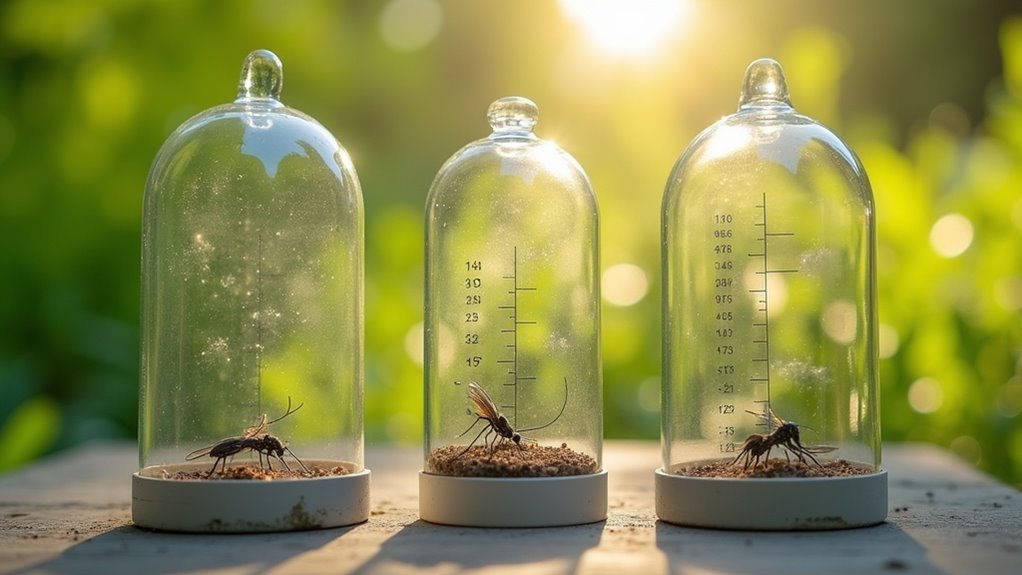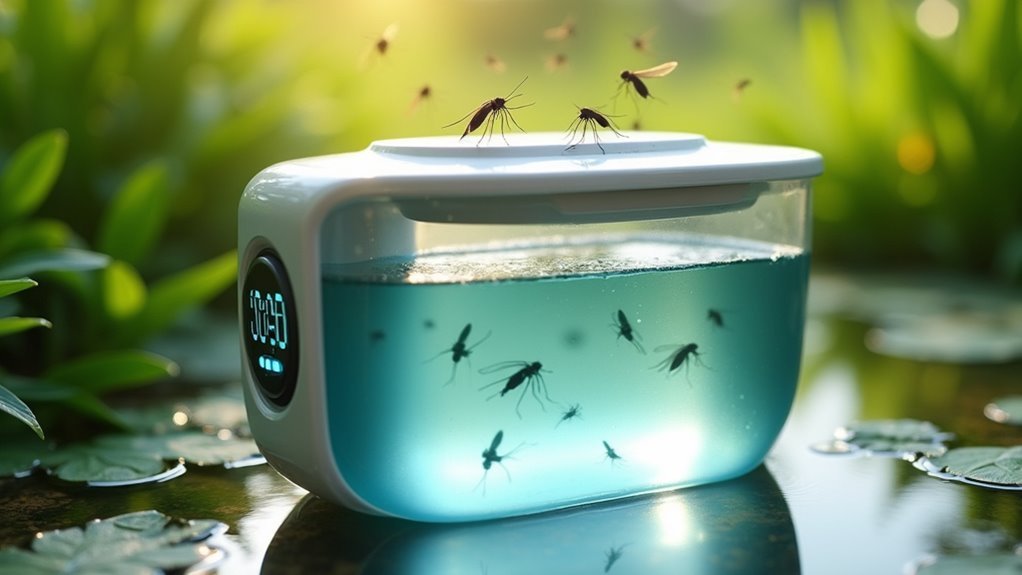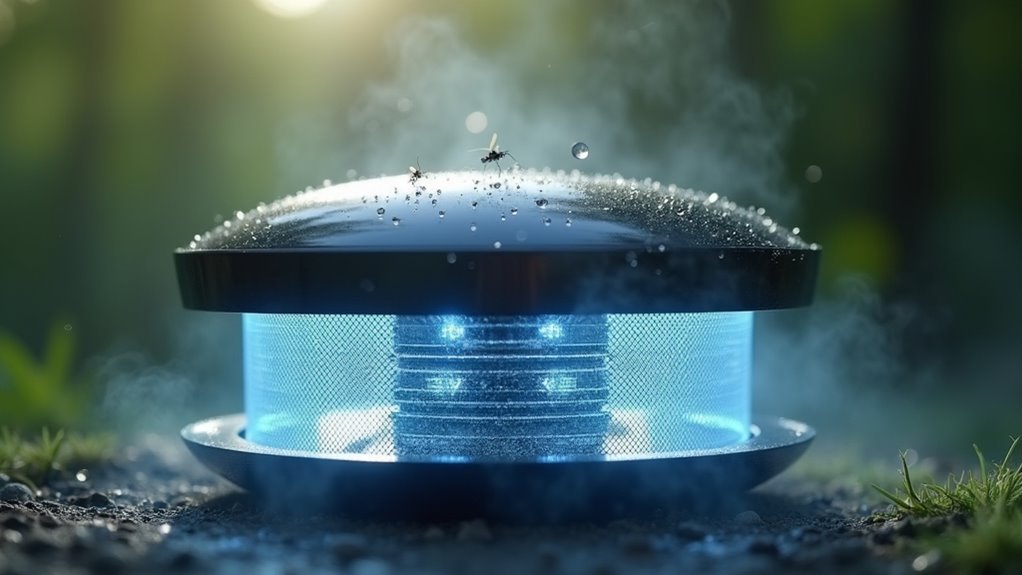You can monitor mosquito populations around your home with remarkable precision using simple counting traps that achieve up to 90% accuracy in distinguishing mosquitoes from other insects. These devices use infrared LED sensors and light detectors to process up to 5 mosquitoes per second, transmitting data every 15 minutes for real-time insights. They’ll also collect environmental data like temperature and humidity while sending instant alerts when populations spike. Discover how to build, place, and maintain these cost-effective monitoring solutions for ideal results.
How Simple Counting Traps Work for Mosquito Detection

Most mosquito counting traps rely on sophisticated infrared LED sensors and light detectors that automatically identify and count mosquitoes as they enter the device.
These sensors differentiate mosquitoes from other insects and dust particles with up to 90% accuracy, ensuring you’re getting reliable data about actual mosquito populations. You’ll capture detailed information rapidly, as these traps can process up to 5 mosquitoes per second for continuous field monitoring.
Advanced infrared sensors achieve 90% accuracy in mosquito identification while processing up to 5 insects per second for reliable population monitoring.
The system automatically transmits data every 15 minutes, giving you high-density population information that identifies hotspots for targeted control.
You’ll also receive environmental data including temperature, humidity, and ambient light levels. Through web-based integration, you can access real-time monitoring capabilities with thorough data visualization tools that help optimize your mosquito control strategies.
Essential Features of Accurate Mosquito Counting Devices
You’ll want accurate mosquito counting devices that incorporate automated species detection technology using patented infrared sensors and light detectors, achieving up to 90% accuracy in field conditions.
Real-time data transmission capabilities guarantee you’re receiving updated mosquito population counts every 15 minutes, allowing for immediate response to changing conditions.
These essential features transform simple traps into sophisticated monitoring systems that can process up to 5 mosquitoes per second while continuously feeding data to your control strategy.
Automated Species Detection Technology
While traditional mosquito traps rely on basic attraction methods, automated species detection technology revolutionizes how you identify and count these pests with scientific precision.
Advanced mosquito trap systems like the BG-Counter 2 use patented insect sensors with infrared LEDs and light detectors to achieve 90% accuracy in differentiating mosquitoes from other insects and dust particles.
This automated species detection technology delivers exceptional benefits:
- Real-time mosquito counts every 15 minutes with capability to record up to 5 mosquitoes per second
- Continuous environmental monitoring tracking temperature, humidity, and ambient light for behavior analysis
- Instant threshold alerts triggering immediate control measures when mosquito populations spike
The integrated app provides data visualization at multiple temporal resolutions, enabling you to analyze trends and identify hotspots for more effective accurate counting strategies.
Real-Time Data Transmission
Advanced mosquito counting devices transform raw detection data into actionable intelligence through sophisticated real-time data transmission systems.
You’ll receive continuous updates every 15 minutes, ensuring you’re always informed about current mosquito activity levels at your trap locations. This frequent data transmission allows your mosquito trap to deliver accurate counting information without delays that could compromise control efforts.
The system automatically monitors environmental conditions alongside mosquito counts, providing extensive situational awareness. You can track temperature, humidity, and other factors that influence mosquito behavior patterns.
When threshold values are exceeded, you’ll receive immediate alerts prompting swift control measures. This real-time connectivity enables you to respond quickly to population surges, optimizing your mosquito management strategy through timely, data-driven decisions.
Setting up Your DIY Mosquito Trap With Counting Mechanism

You’ll need to gather your container, digital scale, Arduino microcontroller, and funnel before starting assembly.
Install the counting sensor by connecting your digital scale to the microcontroller, then program it to log weight changes and convert them to mosquito counts.
Position your completed trap in areas where mosquitoes congregate, ensuring it’s level and protected from direct rain while remaining accessible for regular monitoring.
Essential Components Assembly
The foundation of an effective DIY mosquito trap with counting capability starts with preparing a 2-liter plastic bottle as your main container.
You’ll cut it in half to create the basic structure where your trap works efficiently.
Your essential components include:
- Infrared or light sensor – Mount this at the entrance to detect when mosquitoes enter, enabling accurate tracking of the number of insects captured.
- Arduino microcontroller – This low-power device processes sensor data and maintains your digital counter for real-time monitoring.
- CO2 generation system – Set up yeast fermentation to produce carbon dioxide, which attracts mosquitoes more effectively than UV light to attract them.
Position your assembled trap in shaded areas away from competing light sources for ideal performance and regular maintenance access.
Counting Sensor Installation
Installing your counting sensor requires precision to guarantee accurate mosquito detection and data collection. You’ll need an infrared LED sensor that differentiates mosquitoes from other insects, assuring higher accuracy rates.
Position the counting sensor near your mosquito trap’s entrance or funnel where mosquitoes are naturally drawn. This strategic placement maximizes detection effectiveness as insects enter the trap.
Connect your sensor to a data logging device or microcontroller that tracks counts continuously. This setup enables thorough analysis of mosquito activity patterns over time.
Establish a reliable power source using batteries or solar panels to maintain consistent operation without interruptions during extended trapping periods.
Regular calibration and maintenance are essential for sustained accuracy. Clean the sensor regularly and verify its detection capabilities to assure precise counting and effective monitoring of local mosquito population trends.
Trap Positioning Setup
With your counting sensor properly installed, strategic trap positioning setup becomes your next priority for maximizing mosquito capture rates.
Proper placement directly impacts how effectively you’ll attract mosquitoes and guarantee your counting mechanism delivers peak performance.
Follow these positioning guidelines:
- Height placement: Position your trap 3 to 5 feet off the ground to capture various mosquito species that fly at these levels.
- Location selection: Place traps in shaded areas near standing water where mosquitoes naturally breed and rest.
- Attractant enhancement: Use CO2 or BG-Lure near your trap to considerably boost catch rates.
Regular maintenance checks guarantee your counting system functions properly and the collection area remains debris-free for accurate monitoring.
Best Locations for Placing Counting Traps Around Your Property

Strategic placement of counting traps dramatically impacts their effectiveness in monitoring mosquito populations around your property.
Focus your placement near standing water sources like ponds, bird baths, or drainage areas where mosquitoes breed and feed. Target shaded areas under trees, eaves, or covered patios since mosquitoes prefer cooler environments over direct sunlight.
Position traps within high vegetation such as gardens, shrubs, and dense foliage where mosquitoes shelter during daylight hours.
Install traps 10-15 feet away from patios, doorways, and other human activity zones to prevent interference with counting accuracy while maintaining effective monitoring coverage.
Vary trap heights throughout your property to capture different mosquito species, as some fly close to ground level while others prefer higher positions in trees and bushes.
Reading and Interpreting Mosquito Count Data for Effective Control
Once you’ve positioned your traps correctly, the real value comes from analyzing the mosquito count data they collect. The BG-Counter App transforms raw numbers into actionable insights through detailed graphs and statistics, helping you understand your mosquito population patterns.
Here’s how to maximize your trap’s accurate counting capabilities:
- Monitor 15-minute intervals – Track population density changes throughout the day to identify peak activity periods.
- Set custom threshold alerts – Receive notifications when mosquito counts exceed your predetermined levels, triggering immediate control measures.
- Correlate environmental data – Compare temperature and humidity readings with count data to predict future activity.
Export your data to Excel for deeper analysis across multiple locations and timeframes. This systematic approach guarantees you’re making informed decisions about when and where to implement control strategies.
Maintenance Tips for Long-Term Trap Performance and Accuracy
After you’ve established your monitoring routine, maintaining your mosquito traps becomes essential for guaranteeing consistent, reliable data collection.
These maintenance tips will help preserve accuracy and extend your trap’s lifespan.
Clean the collection area regularly to prevent debris buildup that interferes with counting and performance.
Protect sensors from dust and dirt using a soft cloth, as contaminants affect detection precision.
Inspect the trap’s battery frequently to maintain consistent operation—low power leads to inaccurate data reporting.
Schedule routine checks on CO2 and attractant supplies, since running low decreases effectiveness and skews results.
Update and calibrate the trap’s software when applicable to guarantee it reflects latest specifications and improvements.
Following these practices assures ideal counting accuracy and reliable mosquito monitoring for effective control strategies.
Cost-Effective Solutions for Home Mosquito Population Monitoring
While professional-grade monitoring equipment can be expensive, you don’t need to break the bank to effectively track mosquito populations around your home.
Cost-effective solutions with accurate counting features now make population monitoring accessible to homeowners, eliminating reliance on traditional methods like visual counts.
Modern mosquito monitoring technology puts professional-grade population tracking within reach of every homeowner without the guesswork.
Consider these proven approaches for budget-friendly monitoring:
- Automated counting devices that distinguish mosquitoes from other insects with 90% accuracy, recording up to 5 mosquitoes per second.
- Enhanced trap effectiveness using CO2 and BG-Lure attractants to markedly increase catch rates without expensive equipment.
- Smart monitoring apps that provide detailed statistics and threshold alerts for timely control measures.
These solutions deliver continuous 15-minute reporting intervals, giving you high-density data that traditional methods simply can’t match for effective mosquito population monitoring.
Frequently Asked Questions
What Is the Most Effective DIY Mosquito Trap?
You’ll find the most effective DIY mosquito trap uses sugar, water, and yeast in a cut plastic bottle. The yeast produces CO2 that attracts mosquitoes, while the inverted funnel design traps them inside.
How Do I Make My Yard Mosquito Free?
You’ll eliminate standing water, install bat boxes and birdhouses, plant citronella and lavender, maintain your lawn regularly, and use targeted mosquito traps like the BG-Counter 2 for effective control.
Do Mosquito Dunk Buckets Work?
Yes, mosquito dunk buckets work effectively by releasing Bti bacteria that kills mosquito larvae in stagnant water. You’ll see significant population reduction, but you’ll need additional methods since they don’t capture adult mosquitoes.
Does Dynatrap Really Work?
You’ll find Dynatrap effectively reduces mosquito populations when used consistently for six weeks. It’s proven technology combining UV light and CO2 attracts mosquitoes into its retaining cage, covering up to half-acre properties.
In Summary
You’ve now got the knowledge to build and deploy effective mosquito counting traps around your property. Start with one or two strategically placed devices, monitor the data regularly, and adjust your placement based on what you’re learning. Don’t forget to maintain your traps consistently for accurate readings. With these simple tools, you’ll gain valuable insights into local mosquito populations and can target your control efforts where they’re needed most.





Leave a Reply